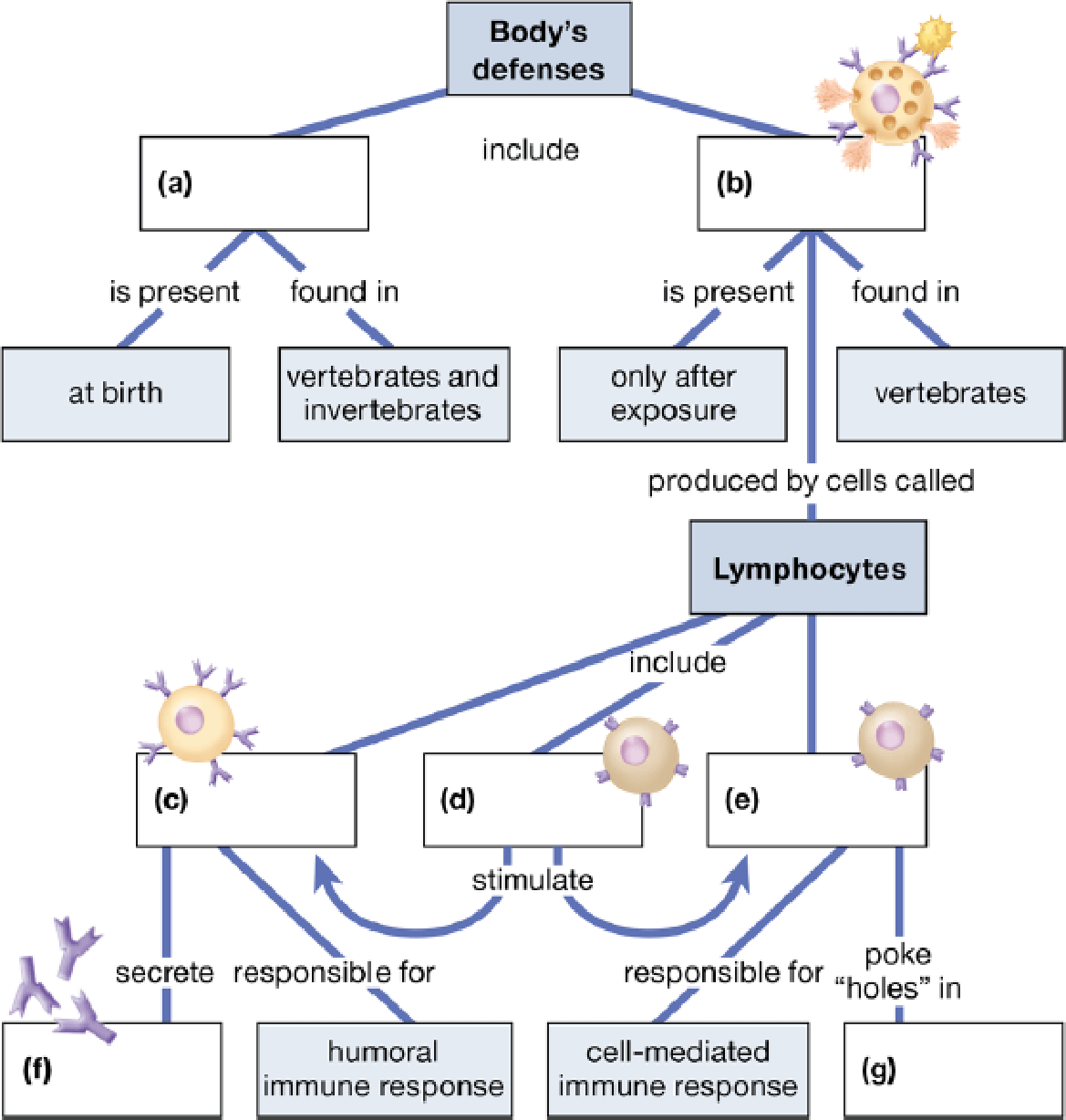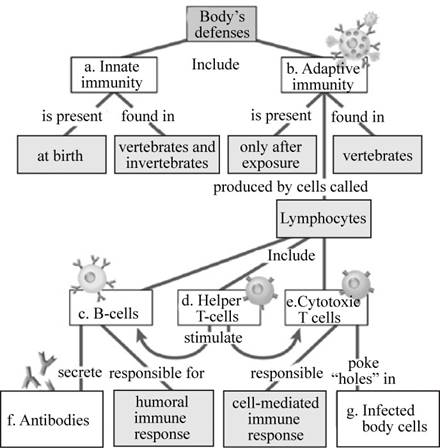
Concept explainers
Complete this concept map to summarize the key concepts concerning the body’s defenses.

To complete: The given concept map and to summarize the key concepts concerning body’s defense.
Introduction:
The immune system of the human body is divided into two main branches, namely the innate immunity and the adaptive immunity. Innate or the body’s first defense mechanism is present since birth and this defense mechanism are non-specific, which means it acts as a barrier in for every foreign body irrespective of its structure. Adaptive immunity of the body comes in later stages, when the body is introduced to pathogens. It is a specific type of defense mechanism.
Answer to Problem 1CC
Pictorial representation: A concept map explaining immune defense mechanisms of body is presented in Fig.1.

Fig. 1: Map depicting the concept of body’s defenses
Explanation of Solution
a)
Correct answer: Innate immunity.
Explanation:
Innate immunity is the immunity present in the body since birththat helps in protecting the body from infection. Hence the correct answer is innate immunity.
(b)
Correct answer: Adaptive immunity.
Explanation:
Adaptive immunity is the immunity that is acquired by the body when the body comes in contact with the foreign agent. Hence the correct answer is adaptive immunity.
(c)
Correct answer: B-cells.
Explanation:
B-cells are the immune cells that help in the protecting the body from infection and is a part of the humoral immunity. Hence the correct answer is B-cells.
(d)
Correct answer: Helper T-cells.
Explanation:
Helper T-cells helps in the recognizing the foreign antigen and instigate the release of antibodies. Hence the correct answer is helper T-cells
(e)
Correct answer: Cytotoxic T cells.
Explanation:
Cytotoxic T-cells help in neutralizing the antigen carrying cell by attaching to it and releasing degenerative enzymes. Hence the correct answer is cytotoxic T cells.
(f)
Correct answer: Antibodies.
Explanation:
Antibodies are protein molecules that help in the recognizing foreign antigen and eliciting an immune response. Hence the correct answer is antibodies.
(g)
Correct answer: Infected body cells.
Explanation:
Infected body cells are the host’s cells that are penetrated by the infectious agent. Hence the correct answer is infected body cells.
Want to see more full solutions like this?
Chapter 24 Solutions
CAMP.BIO:CONC...MOD.MAST+PRINT>I<
- What is this?arrow_forwardMolecular Biology A-C components of the question are corresponding to attached image labeled 1. D component of the question is corresponding to attached image labeled 2. For a eukaryotic mRNA, the sequences is as follows where AUGrepresents the start codon, the yellow is the Kozak sequence and (XXX) just represents any codonfor an amino acid (no stop codons here). G-cap and polyA tail are not shown A. How long is the peptide produced?B. What is the function (a sentence) of the UAA highlighted in blue?C. If the sequence highlighted in blue were changed from UAA to UAG, how would that affecttranslation? D. (1) The sequence highlighted in yellow above is moved to a new position indicated below. Howwould that affect translation? (2) How long would be the protein produced from this new mRNA? Thank youarrow_forwardMolecular Biology Question Explain why the cell doesn’t need 61 tRNAs (one for each codon). Please help. Thank youarrow_forward
- Molecular Biology You discover a disease causing mutation (indicated by the arrow) that alters splicing of its mRNA. This mutation (a base substitution in the splicing sequence) eliminates a 3’ splice site resulting in the inclusion of the second intron (I2) in the final mRNA. We are going to pretend that this intron is short having only 15 nucleotides (most introns are much longer so this is just to make things simple) with the following sequence shown below in bold. The ( ) indicate the reading frames in the exons; the included intron 2 sequences are in bold. A. Would you expected this change to be harmful? ExplainB. If you were to do gene therapy to fix this problem, briefly explain what type of gene therapy youwould use to correct this. Please help. Thank youarrow_forwardMolecular Biology Question Please help. Thank you Explain what is meant by the term “defective virus.” Explain how a defective virus is able to replicate.arrow_forwardMolecular Biology Explain why changing the codon GGG to GGA should not be harmful. Please help . Thank youarrow_forward
- Stage Percent Time in Hours Interphase .60 14.4 Prophase .20 4.8 Metaphase .10 2.4 Anaphase .06 1.44 Telophase .03 .72 Cytukinesis .01 .24 Can you summarize the results in the chart and explain which phases are faster and why the slower ones are slow?arrow_forwardCan you circle a cell in the different stages of mitosis? 1.prophase 2.metaphase 3.anaphase 4.telophase 5.cytokinesisarrow_forwardWhich microbe does not live part of its lifecycle outside humans? A. Toxoplasma gondii B. Cytomegalovirus C. Francisella tularensis D. Plasmodium falciparum explain your answer thoroughly.arrow_forward
- Select all of the following that the ablation (knockout) or ectopoic expression (gain of function) of Hox can contribute to. Another set of wings in the fruit fly, duplication of fingernails, ectopic ears in mice, excess feathers in duck/quail chimeras, and homeosis of segment 2 to jaw in Hox2a mutantsarrow_forwardSelect all of the following that changes in the MC1R gene can lead to: Changes in spots/stripes in lizards, changes in coat coloration in mice, ectopic ear formation in Siberian hamsters, and red hair in humansarrow_forwardPleiotropic genes are genes that (blank) Cause a swapping of organs/structures, are the result of duplicated sets of chromosomes, never produce protein products, and have more than one purpose/functionarrow_forward
 Human Heredity: Principles and Issues (MindTap Co...BiologyISBN:9781305251052Author:Michael CummingsPublisher:Cengage Learning
Human Heredity: Principles and Issues (MindTap Co...BiologyISBN:9781305251052Author:Michael CummingsPublisher:Cengage Learning Human Physiology: From Cells to Systems (MindTap ...BiologyISBN:9781285866932Author:Lauralee SherwoodPublisher:Cengage Learning
Human Physiology: From Cells to Systems (MindTap ...BiologyISBN:9781285866932Author:Lauralee SherwoodPublisher:Cengage Learning Biology: The Dynamic Science (MindTap Course List)BiologyISBN:9781305389892Author:Peter J. Russell, Paul E. Hertz, Beverly McMillanPublisher:Cengage Learning
Biology: The Dynamic Science (MindTap Course List)BiologyISBN:9781305389892Author:Peter J. Russell, Paul E. Hertz, Beverly McMillanPublisher:Cengage Learning Human Biology (MindTap Course List)BiologyISBN:9781305112100Author:Cecie Starr, Beverly McMillanPublisher:Cengage Learning
Human Biology (MindTap Course List)BiologyISBN:9781305112100Author:Cecie Starr, Beverly McMillanPublisher:Cengage Learning Medical Terminology for Health Professions, Spira...Health & NutritionISBN:9781305634350Author:Ann Ehrlich, Carol L. Schroeder, Laura Ehrlich, Katrina A. SchroederPublisher:Cengage Learning
Medical Terminology for Health Professions, Spira...Health & NutritionISBN:9781305634350Author:Ann Ehrlich, Carol L. Schroeder, Laura Ehrlich, Katrina A. SchroederPublisher:Cengage Learning





